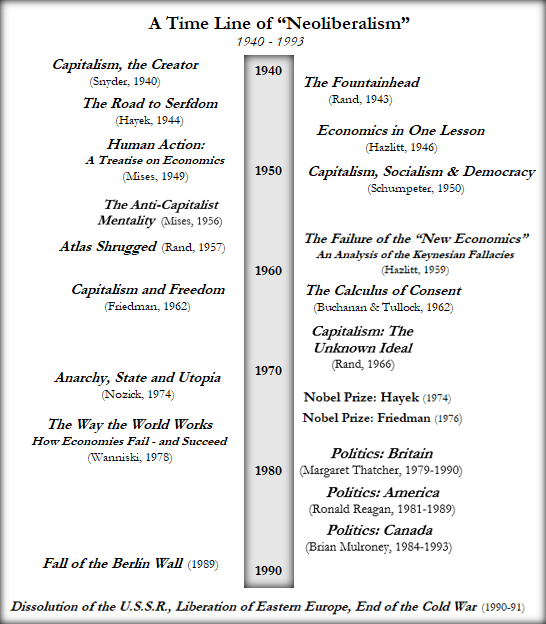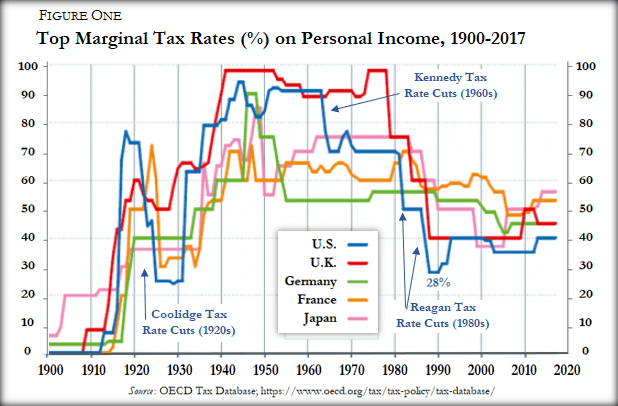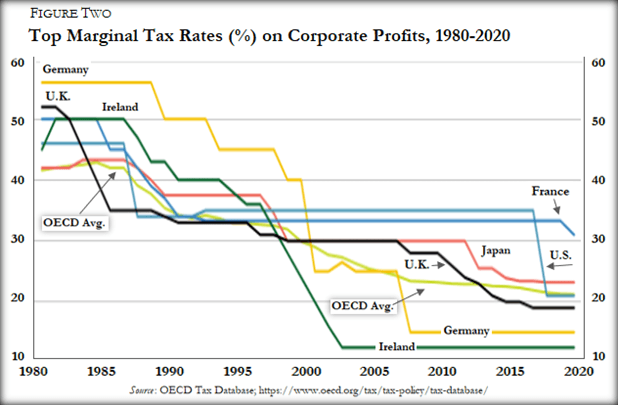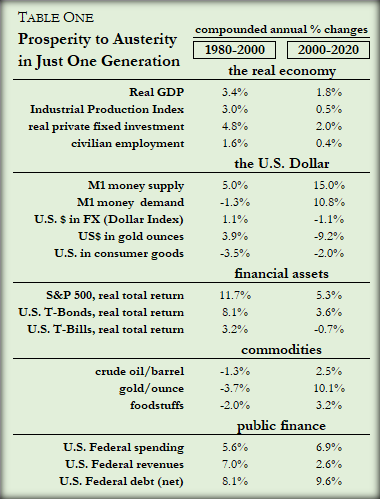Supply-Side Neoliberalism Sure Beats the Alternative

Besides “capitalism,” the two concepts perhaps most reviled by left-leaning intellectuals are “neoliberalism” and “supply-side economics.” These intellectuals harbor an odd antagonism, because each concept is associated with greater freedom, prosperity, and security. As such, one might suspect that the antagonists yearn for something other than these human values.
But what’s not to like about capitalism? It’s the social system that codifies individual rights to life, liberty, property, and the pursuit of happiness, the system in which property is owned and controlled privately. Capitalism was made possible by the Enlightenment, by the 18th century respect for reason in all fields – in science, politics, economics, the arts. In just a couple of centuries it revolutionized and modernized our material world; for the nations that embraced it, capitalism improved their health, increased their wealth, and extended their lifespans.
We no longer have a pure capitalist system, of course. The ideal form was best practiced in America between the Civil War and WWI. But whenever social systems have been closer to capitalism’s pure form (e.g., Hong Kong), they have performed wonders; systems farthest from capitalism, we all know (or should) have produced horrors.
Why does capitalism perform wonders? Why is it so efficient, practical, productive, and life-enhancing? Because it is the optimal habitat for humanity. It provides individuals the freedom to think, act, and pursue their self-interest. Some of capitalism’s foes are nihilists, of course, eager to terminate (not merely “redistribute”) its opulence; but many more foes disdain its ethical code of rational egoism, a disdain felt alike by secular socialists and religious conservatives (who otherwise pose as rivals). Many also hate inequalities in income, wealth, and social status, even though in freer nations that mostly reflects the diversity of developed talents and life choices.
What about “neoliberalism?” It means “new liberty” and refers to the post-WWII spread of pro-capitalist ideas from the likes of Ludwig von Mises, Friedrich Hayek, Ayn Rand, Milton Friedman, Robert Nozick, James Buchanan, and others. Liberty had not been as defended since before WWI.
The nearby exhibit – “A Timeline of Neoliberalism” – depicts key works in moral theory, politics, and economics that appeared over five decades and inspired party platforms, campaigns, and elections. The successful, multi-year governance of political leaders like Ronald Reagan, Margaret Thatcher, and Brian Mulroney would not have been possible without the fuel of neoliberal ideas. Nor would there have been pressure placed on the Soviet Union and its East European colonies; when they too relented, it could be said without hyperbole (as Thatcher put it) that neoliberals “won the Cold War without firing a single shot.” Even successors to the neoliberals in rival parties dared not change policy much. In the 1990s Bill Clinton first beat the Reagan successor (GHW Bush) who had pledged “no new taxes” (before raising them), then, before a Republican-controlled Congress, declared “the era of big government is over.” Soon thereafter, Clinton signed a law to “end welfare as we know it.” In Britain in 1995, Labor Party leader Tony Blair demanded a recission of the nationalization plank (in place since 1918) and with other neoliberal acts served as Prime Minister (1997-2007).

Amid the rise of neoliberalism and the fall of the U.S.S.R., Marxism and Keynesianism were in disrepute and retreat. Ideologues and control freaks in each camp detested the spread of neoliberalism; still today they use the term as an epithet, preferring a return to the old despotism.
What about “supply-side economics?” It was developed primarily by economists Robert Mundell (Nobel prize winner, 1999) and Arthur Laffer (famous for the Laffer curve, which showed the disincentive effects of high marginal tax rates and called for material cuts). Their work was popularized by Jude Wanniski (The Way the World Works, 1978) and Bob Bartley (in charge of the editorial pages of the Wall Street Journal, 1972-2002). Supply-side doctrines were applied with great success by practitioners including Congressman Jack Kemp, Treasury economists Paul Craig Roberts (The Supply-Side Revolution, 1984) and Bruce Bartlett – and, of course, America’s 40th President – in the form of “Reaganomics.” It is true (and sad) that few supply-siders were willing to shrink the morally suspect welfare state, but neither were their critics (who demanded a still larger version). Besides, their failure to get shrinkage does not negate their valid principles, one of which is that the real burden on the economy is government spending, not how it is financed.
Just as many intellectuals and politicians despised neoliberalism, they despised supply-side economics, deriding it as “voodoo economics” and “trickle-down economics.” Even Reagan budget director David Stockman, a brief convert, tried to appease critics by claiming it was a “trojan horse” to provide “giveaways to the rich.” Despite foes’ smears, supply-side economics was neither untrue nor untried; it was a healthy revival of the sound doctrines and policies explicated by Jean-Baptiste Say (1767-1832), Frederic Bastiat (1801-1850), and Joseph Schumpeter (1883-1950). The trio’s pro-capitalist ideas and policies were dismissed and distorted (albeit never refuted) under the onslaught of Marxian-Keynesian dogmas during the brutal first half of the 20th century.
The essence of supply-side economics is not, as critics claim, that “tax cuts will balance the budget.” It’s not even a minor principle but, rather, a “straw man” argument which no supply-sider ever advanced. Budget balance (or imbalance) is determined as much by public spending as by tax revenues; if the former is excessive, no amount of tax reform can ensure budget balance. Moreover, the uniqueness of the supply-side approach to taxation is to focus on tax rates and how they affect incentives to produce, earn income, save, and invest. Unlike most other models, this one makes the reasonable assumption that people are self-interested, don’t pay taxes out of duty, and dislike paying their hard-earned income to corrupt and fiscally profligate governments.
Supply-side fiscal theory contends that if tax rates are too high (confiscatory, punitive) they can depress the tax base and thus tax revenues. If so, a cut in rates can increase output and income as well as the tax base (hence tax revenues). This is common sense, basic economics; it is price theory (microeconomics) applied to the economy (macroeconomics) and to public finance. It is the essence of the Laffer curve, which has been verified empirically in dozens of cases worldwide since the 1970s. It is precisely the much-reviled supply-side revolution that fueled the case for material cuts in top marginal tax rates in major nations since the early 1980s (Figure One) – and those cuts also, predictably, fueled a revival in economic growth rates in those nations.

Another major myth about supply-side economics is that it pertains only to taxes or to the maximization of government revenues. As did Say, Bastiat, and Schumpeter, supply-siders today rightly extoll entrepreneurship, profit-seeking, and prosperity. They know that wealth creation requires the rule of law, the protection of all aspects of private property rights, sound (gold-based) money, low and flat tax (and tariff) rates, free trade, efficient infrastructure, and national defense. For supply-siders, the real burden on any economy is government spending, not how it’s funded. Unlike demand-siders (whether Keynesian or Monetarist), they stress supply, production, and wealth creation; they recognize that supply is the only source of real demand, that demand is not akin to consumption (the using up of wealth), that government spending per se creates neither supply nor demand, that aggregate supply and aggregate demand are never “out of balance” or in need of a government corrective, since they’re the same thing viewed from different angles.
Figures One and Two illustrate the dramatic decline on top marginal tax rates resulting from the supply-side revolution of the 1980s and 1990s. The U.S. federal government’s top marginal tax rate on personal income (Figure One) was cut from 70% in 1980 to 50% by 1983, then further to a low of 28% in 1986 (a rate that lasted for only five years, until the Bush tax hikes). Notice how tax rates likewise were cut in Britain, Germany, France, and Japan. This was a global revolution. Yet rates have been raised again in the opening decades of this century. The top U.S. rate is now 40%.
Top corporate tax rates also were cut dramatically due to the supply-side revolution (Figure Two). In 1984 top marginal rates averaged 42% in OECD nations; by 1999 the average was 32%; today it is 22%. Germany’s top rate was 55% in 1980; by 1999 it was 40%; today it is 14%. The top U.S. rate for large “C-corporations” was cut from 46% in 1980 to 35% in 1986 and remained there, above the OECD average, until the Trump rate cut (to 21%) beginning in late 2017. In the U.S., the top tax rate for smaller, pass-through business entities (“S-corporations”) was equivalent to the top personal rate, which was cut from 70% in 1980 to 28% in 1986; this tax-rate differential inspired faster growth in small-to-midsize businesses in the U.S. relative to larger firms.

A crucial aspect of the supply-side revolution was pro-capitalism and anti-cronyism. A main goal was to simplify the tax code, with fewer brackets and fewer special exemptions, deductions, and credits. Private sector activity would shift from tax avoidance to wealth creation. The idea was to lower tax rates while widening and increasing the tax base (i.e., taxable income). That meant a much lower negative impact on total tax revenues. Moreover, less onerous tax rates and fewer tax favors radically reduced the motivation to lobby for special tax breaks (i.e., far less cronyism).
The supply-side revolution – being pro-capitalist, pro-entrepreneur, pro-profit, pro-growth, and pro-prosperity – understandably has faced many counterrevolutionaries in the early decades of this century. Top marginal tax rates on personal income have been increased, although not back to pre-1980 confiscatory levels; pressure is building to further raise top rates, and politicians who endorse the idea have been gaining traction and getting elected. The reactionaries also have been busy reintroducing tax favoritism, eliciting more lobbying, campaign contributions, and cronyism.
We have heard a lot in recent decades about capitalism allegedly degenerating into “cronyism” or “plutocracy” (rule by the rich). But cronyism has nothing to do with capitalism. The only way to get money out of politics is to get politics out of money making. That is a uniquely supply-side prescription, but it is the last thing in the world any Marxist, Keynesian, or welfare-state fan wishes to see. It is ludicrous when foes of supply-side policy claim that it “favors the rich,” for these foes are the same people who, by seeking to punish the rich, insidiously seek their favors.
Tax policy aside, there has also been a boom in government spending this century, which supply-siders interpret as a burden (not a “stimulus”) for the economy. There also has been greater regulation, stemming from 9/11 (PATRIOT ACT), the accounting scandals of the early 2000s (Sarbanes-Oxley Act), the financial crises of 2008-09 (the Dodd-Frank Act), and the Covid-19 lockdowns of 2020-21. Finally, there have been sharp policy turns away from free trade.
Back in 2012, fearful of a Romney-Ryan victory and a mere preservation of supply-side policies, two analysts at the left-leaning Center for American Progress issued a report titled “The Failure of Supply-Side Economics.” They included a half dozen graphs allegedly showing that “supply-side doesn’t work.” They showed no such thing. They cherry-picked data, conveniently altered time periods, and posited irrelevancies. Their shoddy work was yet another in a long train of similarly bogus “studies” that have appeared since the beginning of Reaganomics in the early 1980s.
Let us review the relevant empirics, both fully and fairly. Table One summarizes and contrasts U.S. economic-financial performance in 1980-2000 versus 2000-2020. Whereas the last two decades of the 20th century were animated by globalism and supply-side neoliberalism, the first two decades of the 21st century have been animated by nationalism and demand-side neofascism.
The extent of the differential performance should be astonishing to those unaware of the facts but honest enough to learn them. Tragically, America has shifted from prosperity to austerity in a single generation. Real GDP growth was 3.4% per annum in 1980-2000, twice the rate of 2000-2020. Industrial production over the last two decades has been a mere 1/6th of the previous annual rate. Real private fixed investment expanded by 4.8% per annum in 1980-2000, more than double the rate since then. Growth in civilian employment this century has been a mere quarter of what it was in 1980-2000.
What about the dollar and money? The dollar appreciated at a compounded annual rate of 1.1% in 1980-2000 but depreciated at that same rate in 2000-2020. In real terms (ounces of gold), the dollar appreciated 3.9% per annum in 1980-2000 but has been devalued 9.2% per annum since then. The money supply has increased 15% per annum so far this century, triple its rate of increase in 1980-2000. To what end? For what purpose? Obviously, the production of money isn’t the production of real wealth. As more money has been issued, more has been demanded (hoarded). That hardly depicts a robust, future-oriented, risk-taking, entrepreneurial economy.

What about real gains on financial assets? The S&P 500 returned 11.7% per annum in the supply-side decades of 1980-2000, more than double what it has delivered since then (5.3% per annum). U.S. T-Bonds returned 8.1% per annum in 1980-2000, likewise double their return since (3.6% per annum). Prices of key commodities like crude oil, gold, and food declined in 1980-2000, but have since increased. With robust growth in output and jobs in 1980-2000 came less costly living.
What about U.S. public finances? The supply-side policy mix is ridiculed most, perhaps, for its alleged fiscal profligacy. But Table One reveals how federal spending has increased far more in 2000-2020 (6.9% per annum) than it did amid supply-side dominance in 1980-2000 (5.6% per annum). Recent profligacy hasn’t done very much to “stimulate” the economy, has it? But surely federal tax revenues stagnated amid all the tax cutting of 1980-2000? No, they grew by 7.0% per annum, more than twice their growth rate so far this century. Whereas in 1980-2000 revenue growth outpaced spending growth, the reverse has occurred in 2000-2020, with spending growth outpacing revenue growth. The result: a relatively faster rise in the national debt this century. The turn of the last century recorded four straight years (1998-2001) of budget surpluses. So much for fiscally “reckless” supply-side policies. The U.S has registered not a single surplus since 2001.
The near-phobic disdain for supply-side economics and neoliberalism this century is part of a new wave of anti-capitalist sentiment. We have seen this movie before. It is a horror film. The true friends of rationality, liberty, and prosperity should wake up, stand proudly, and contend boldly.











